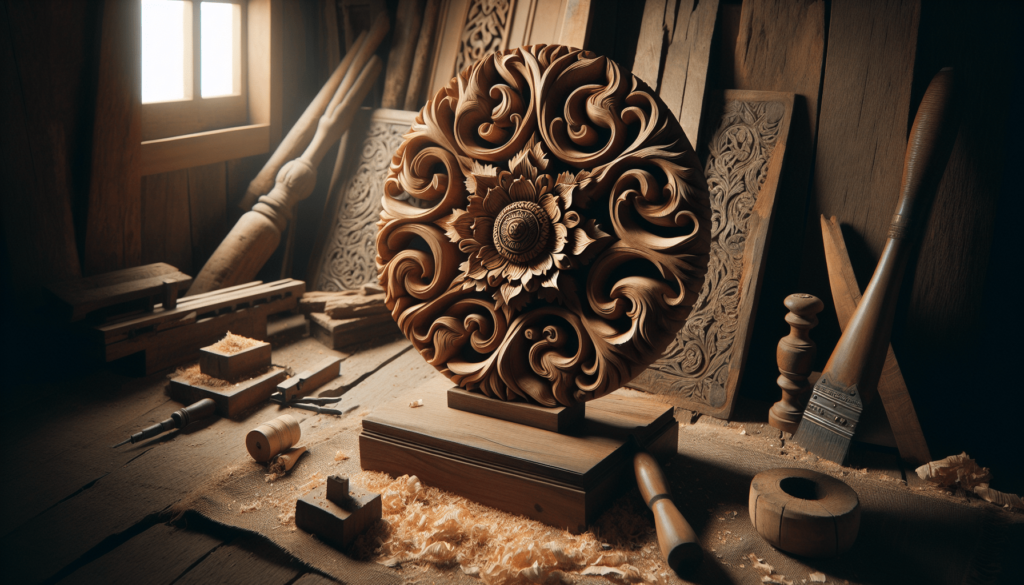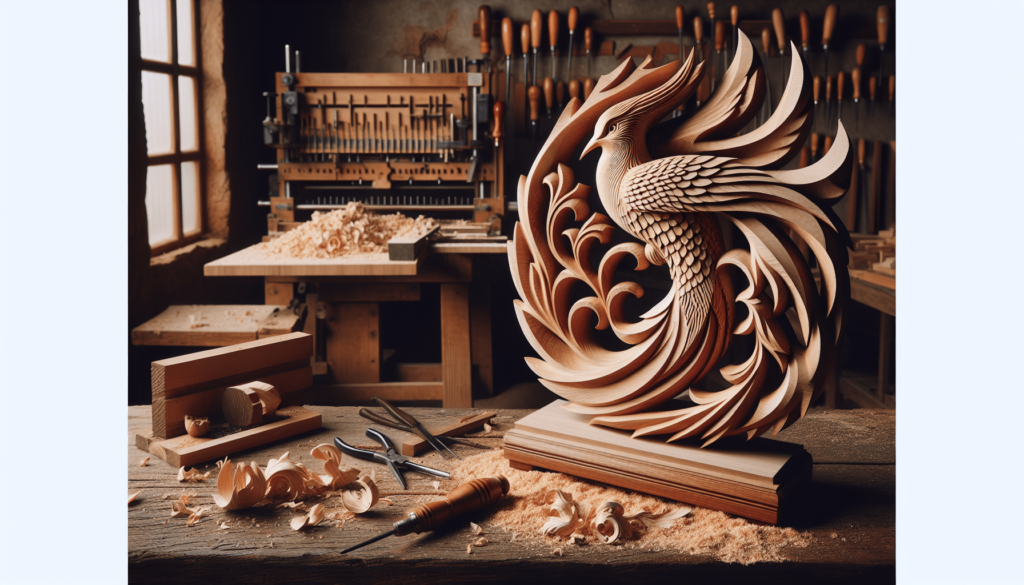Have you ever wondered what wood crafting is called? If you’re like me, you’ve probably seen stunning wooden furniture or intricate carvings and thought, “What kind of sorcery is this?” Trust me, you’re not alone. I’m here to walk you through the fascinating world of wood crafting, which, spoiler alert, isn’t just called one thing. There’s a whole lexicon for this art form! So, grab a seat and let’s unravel the tale of wood crafting.
What Exactly Is Wood Crafting?
Wood crafting is a catch-all term for various techniques and processes used to create objects from wood. Ever heard of a woodworking project or a wooden sculpture and wondered whether they fall under the same category? The answer is a resounding yes! Whether it’s whittling a simple figure, turning a bowl on a lathe, or building an elaborate piece of furniture, it’s all wood crafting.
Different Terms in Wood Crafting
You might be surprised to learn that wood crafting goes by many names, each with subtle differences. Here’s a handy table to break them down:
| Term | Definition |
|---|---|
| Carpentry | The trade of cutting, shaping, and installing building materials, primarily wood. |
| Woodworking | The craft of creating items from wood, which includes joinery, carving, and woodturning. |
| Joinery | The branch of woodworking focused on joints, such as dovetails and mortises. |
| Woodturning | The process of shaping wood using a lathe. |
| Whittling | The simple act of carving shapes out of wood using a knife. |
| Cabinet Making | The skill of creating furniture like cabinets, tables, and chairs. |
| Marquetry | The art of applying pieces of veneer to form decorative patterns. |
| Luthiery | The craft of making stringed instruments. |
Carpentry: The Basics
Carpentry is probably the most recognizable term. When I think of carpentry, I think of houses being built or repaired. Carpenters are essential in the construction industry because, let’s face it, no one wants to live in a house with wobbly stairs or crooked door frames. Their work mainly involves structural elements.
Woodworking: An Umbrella Term
Woodworking, on the other hand, is more of an umbrella term that encompasses various specialized crafts, including joinery and woodturning. If you’re not just building houses but also making beautiful furniture, you’re a woodworker. You can be both a carpenter and a woodworker, but not all woodworkers are necessarily carpenters.
Joinery: The Art of the Joint
I have this one friend who’s obsessed with joinery. Every time we hang out, he talks about creating tight, seamless joints in wood. Joinery is that specific part of woodworking focused on connecting pieces of wood without nails or screws. Think dovetails, mortises, and tenons. Mastering joinery is like conquering the final level in a complex video game; it’s tough but incredibly rewarding.
Woodturning: Spinning Magic
If you’ve ever marveled at a beautifully turned wooden bowl or spindle, you’ve seen woodturning in action. This craft involves shaping wood while it’s spinning on a lathe, enabling intricate designs and smooth finishes. It’s almost hypnotic to watch, and I can’t help but be fascinated by the skill required.
Whittling: The Old-School Craft
Whittling is as traditional as it gets. Picture an older gentleman sitting on a porch, carving away at a piece of wood with nothing but a knife. That’s whittling for you. It’s the simplest form of wood crafting but takes a lot of patience and a steady hand.
Cabinet Making: Furniture Masters
Cabinet making is what you’d call the Rolls-Royce of wood crafting. These artisans don’t just make cabinets; they craft intricate pieces of furniture that can be both functional and works of art. Their projects often require a high level of precision and creativity.
Marquetry: Wood Meets Art
Marquetry is where wood crafting meets fine art. It involves piecing together veneers to form intricate, decorative patterns and designs. It’s like putting together a puzzle but with pieces you’ve cut yourself. Whenever I see a marquetry piece, I’m always blown away by the detail and craftsmanship involved.
Luthiery: Music to Your Ears
Luthiery is the specialized craft of making stringed instruments like guitars, violins, and cellos. It requires not just woodworking skills but also a deep understanding of acoustics. I can’t even imagine the precision and expertise needed to create a beautifully sounding instrument from a block of wood.
Tools of the Trade
Let’s face it; you can’t craft masterpieces out of wood with your bare hands. Well, you technically could, but it would be an incredibly arduous journey. The right tools can make all the difference. Here are some of the basics.
Hand Tools
Remember the first time you used a hammer and felt like a superhero? Or maybe that was just me. Hand tools are the bread and butter of wood crafting.
- Hammer: For driving nails and, occasionally, fingers.
- Chisels: For carving and shaping wood.
- Hand Saw: For cutting wood into pieces that somewhat resemble your plan.
- Planes: For smoothing and shaping the wood surface.
Power Tools
Once you graduate from the basics, power tools can feel like unlocking a secret level.
- Table Saw: For precise cuts, a power tool staple.
- Drill: This is for everything from creating holes to driving screws; an absolute must.
- Router: For hollowing out an area in wood, basically the Swiss Army knife of power tools.
- Lathe: If you’re into woodturning, this is your new best friend.
Specialized Tools
Ah, the crème de la crème. These tools may not be necessary for everyone but boy, are they fun.
- Scroll Saw: For intricate cuts and designs.
- Band Saw: For cutting irregular shapes and curves.
- Thickness Planer: For ensuring each board is the exact thickness you need.

Techniques and Skills
With great tools come great techniques. Knowing how to wield these instruments effectively is key to becoming a proficient wood crafter. Here are some skills to get you started.
Measuring and Marking
It sounds mundane, but measuring and marking are foundational skills. Think “measure twice, cut once.” Accurate measurements are crucial, or you’ll end up with a wobbly piece of furniture, and no one wants that.
Cutting
Different cuts serve different purposes. Learning to master the various cuts—rip cuts, crosscuts, miter cuts—will go a long way in improving your craftsmanship.
Sanding and Finishing
If you skip sanding, you’re basically sabotaging your own project. Sanding smooths out rough edges and surfaces, making your final product much more polished. Don’t forget the finishing touches like staining and sealing to protect the wood and make it look fabulous.
Joinery Basics
We’ve already talked about joinery, but here’s a closer look. Knowing how to create strong joints is fundamental, whether you’re constructing a table or a tiny wooden box.
Woodturning Techniques
Woodturning isn’t something you can just “wing.” There’s a whole set of techniques involved, from basic spindle turning to advanced hollowing. It takes time, but once you get the hang of it, there’s no limit to what you can create.
Types of Wood
Which type of wood should you use? It’s like asking which wine pairs well with dinner—completely depends on what you’re going for.
Softwoods
Softwoods like pine and cedar are easier to cut and shape, making them ideal for beginners. They’re also generally less expensive, so you won’t feel as bad if you mess up a piece.
Hardwoods
Hardwoods like oak, maple, and cherry are tougher to work with but offer greater durability and a more luxurious finish. They’re often used for high-end furniture.
Exotic Woods
If you really want to get fancy, there are exotic woods like teak, mahogany, and ebony. These are often used for specialized projects where appearance and longevity are crucial.

Common Projects
Now, the fun part! Projects you can tackle depending on your skill level. Here are some ideas.
Beginner Projects
- Birdhouse: Classic, simple, and hard to screw up.
- Picture Frame: A bit more involved but still manageable.
- Simple Shelf: Functional and straightforward.
Intermediate Projects
- Coffee Table: A perfect blend of form and function.
- Jewelry Box: Allows you to practice joinery and finishing.
- Chair: A bit challenging but oh-so-rewarding.
Advanced Projects
- Wardrobe or Armoire: Ultimate test of skill and patience.
- Dining Table: Large, complicated, and very satisfying.
- Musical Instrument: Only if you’re feeling super ambitious.
Modern Applications
Wood crafting isn’t just a relic of the past. It’s alive and well in today’s world, and even intersects with technology.
Woodworking and Innovation
With the advent of CNC machines and other high-tech tools, modern woodworking has expanded what’s possible. From CAD software to laser cutting, technology integrates seamlessly with traditional woodworking techniques.
Sustainable Woodworking
In today’s eco-conscious world, there’s a growing emphasis on using sustainable practices. Reclaimed or recycled wood is increasingly popular, as are techniques that minimize waste.
DIY Culture
Thanks to platforms like YouTube and Pinterest, there’s a resurgence in DIY woodworking projects. People are rediscovering the joy of creating something with their own two hands, often turning it into a lucrative side hustle.
Challenges and Rewards
Every craft has its challenges, and wood crafting is no different. I’ll be honest; it can be frustrating, especially for novices. But the rewards far outweigh the hiccups.
Challenges
- Precision: Even a millimeter off can ruin a project.
- Time: Wood crafting is time-consuming, often requiring hours of focus.
- Materials: Good wood isn’t cheap, and a mistake can be costly.
Rewards
- Satisfaction: The pride of creating something tangible is immeasurable.
- Skill Development: Each project makes you better, honing your skills.
- Legacy: Crafting something that might be used or admired for generations knocks your satisfaction up several notches.
Getting Started
Feeling inspired? Good! Here’s a quick guide to getting started in wood crafting.
Starter Kit
- Basic Tools: Hammer, chisels, hand saw, measuring tape, sanding paper.
- Wood: Start with softwoods like pine or cedar.
- Workspace: A garage or a dedicated corner of your basement works well.
- Plan: Have a clear project in mind, with sketched plans and measurements.
Educational Resources
- Books: There are countless woodworking books; find a few that cover the basics.
- Online Courses: Websites like Udemy and Coursera offer woodworking classes.
- Forums: Join woodworking forums or groups to ask questions and share progress.
Practice
There’s no substitute for hands-on practice. Start small and gradually take on more complex projects as your confidence grows.
Final Thoughts
Wood crafting, by any name, is an incredibly fulfilling endeavor. Whether you’re a novice just whittling away or a seasoned professional crafting heirloom furniture, there’s always something new to learn and appreciate. So, now that you’re equipped with the basics, why not take the plunge?
I hope this guide has shed some light on what wood crafting is called and inspired you to perhaps pick up a chisel or two. There’s a whole world of wood out there just waiting to be transformed by your hands. Happy crafting!
There you have it—an extensive, yet conversational guide on wood crafting. Whether you’re curious or ready to start right away, this might just be the nudge you needed to pursue this timeless art.

